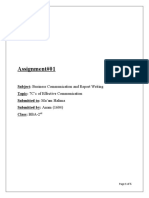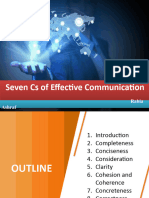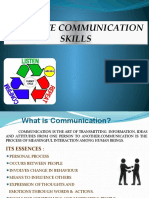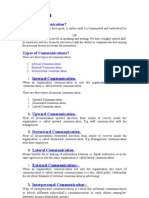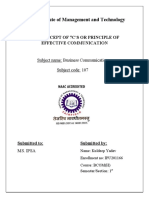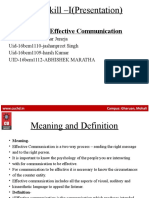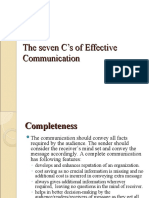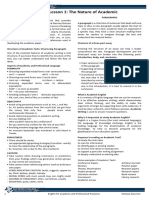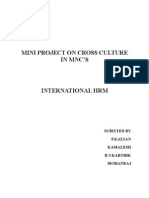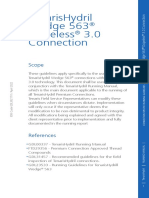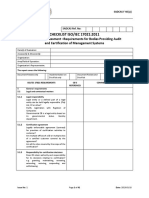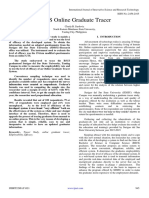COMMUNICATION PRINCIPLES
What is Communication?
The imparting or exchanging of information by speaking, writing or using some other
medium. …The successful conveying or sharing of ideas and feelings. – Oxford
Dictionary
Communication describes the process of conveying messages (facts, ideas, attitudes,
and opinions) from one person to another so that they are understood. - M.W.
Cumming
“Communication is an exchange of facts, ideas, opinions or emotions by two or more
persons” – Newman and Summer
“Communication is the transmission and interchange of facts, ideas, feelings or course
of action” – Leland Brown
“Communication is the sum of all the things one person does; when he wants to create
understanding in the mind of another. It involves a systematic and continuous process
of telling, listening, and understanding” – Allen Lewis
1
�Characteristics of Effective Communication
The 7 C’s of Communication
There are 7
C’s of effective communication which are applicable to written, as well as
oral communication. These are as follows:
1. Completeness
➔ The communication must be c omplete. It should convey all facts required by the
audience.
➔ In a complete message, the audience has everything they need to be informed
and, if applicable, take action.
Things to consider to ensure completeness:
➔ Does your message include a “call to action,” so that your audience clearly
knows what you want them to do?
➔ Have you included all relevant information – contact names, dates, times,
locations, and so on?
➔ A complete communication has the following features:
◆ It leaves no questions in the mind of the receiver.
◆ Complete communication helps in better decision-making by the
audience/readers/receivers of the message as they get all desired and
crucial information.
2
�2. Conciseness
➔ When you’re concise in your communication, you stick to the point and keep it
brief. Your audience doesn’t want to read six sentences when you could
communicate your message in three!
➔ Conciseness means communicating what you want to convey in the least
possible number of words without forgoing the other C’s of communication.
➔ Conciseness is a necessity for effective communication.
Things to consider:
◆ Are there any adjectives or “filler words” that you can delete? You can
often eliminate words like “for instance,” “you see,” “definitely,” “kind of,”
“literally,” “basically,” or “I mean.”
◆ Are there any unnecessary sentences?
◆ Have you repeated the point several times, in different ways?
➔ Concise communication has the following features:
◆ It is time-saving as well as cost-saving.
◆ It underlines and highlights the main message as it avoids using
excessive and needless words.
◆ A concise message is more appealing and comprehensible to the
audience than a wordy, rambling message.
◆ A concise message is non-repetitive in nature.
3. Consideration
➔ Consideration implies respect for the reader’s point of view.
3
�➔ Effective communication must take the audience into consideration, i.e., the
audience’s viewpoints, background, mindset, education level, gender, etc.
➔ Make an attempt to envisage your audience, their requirements, emotions as
well as problems.
➔ Modify your words to suit the audience’s needs while still keeping your
message complete.
➔ Features of considerate communication are as follows:
◆ Emphasis on a “you” approach.
◆ Avoid gender bias.
◆ Empathize with the audience and exhibit interest in the audience. This
will stimulate a positive reaction from the audience.
4. Clarity
➔ The communicator must be clear on the following:
◆ What is the objective of communication?
◆ What is to be communicated?
◆ Which medium will prove to be the most suitable for this purpose?
➔ For clarity of expression:
◆ Use simple, easy-to-understand words (‘use’ instead of ‘utilize’, ‘help’
instead of ‘facilitate’)
◆ Use single words instead of long phrases (‘please’ instead of ‘will you be
kind enough’; ‘for’ instead of ‘for the purpose of’)
◆ Use verbs for nouns (‘decide’ instead of ‘make a decision’)
4
� ◆ Avoid double entry (‘fact’ instead of ‘actual fact’, ‘return’ instead of ‘return
back’)
◆ Use concrete expressions that have a visual impact on the mind and will
be easy to remember
◆ Avoid jargon (‘thanks for your letter’ instead of ‘we acknowledge your
correspondence’)
◆ Avoid ambiguity (‘Go slow. Work in progress’ instead of ‘Go. Slow work
in progress’)
◆ Write short sentences!
5. Concreteness
➔ When your message is concrete, then your audience has a clear picture of what
you’re telling them. There are details (but not too many!) and vivid facts, and
there’s a laser-like focus. Your message is solid.
➔ A concrete message has the following features:
◆ It is supported by specific facts and figures.
◆ It makes use of words that are c lear.
◆ Concrete messages are not misinterpreted.
6. Courtesy
➔ Courteous communication is friendly, open, and honest. There are no hidden
insults or passive-aggressive tones. You keep your reader’s viewpoint in mind,
and you’re empathetic to their needs.
➔ A courteous message has the following features:
◆ Courtesy implies taking into consideration the viewpoints and feelings of
the receiver of the message.
5
� ◆ A courteous message is positive and focused on the audience.
◆ It makes use of terms showing respect for the receiver of the message.
➔ Make your message courteous by:
◆ Replying promptly
◆ Apologize for any omissions
◆ Thank people for any favours they have done you
7. Correctness
➔ When your communication is correct, it fits your audience. Correct
communication is also error-free communication.
Things to consider to ensure your communication is correct:
◆ Do the technical terms you use fit your audience’s level of education or
knowledge?
◆ Is the language you have used appropriate for your audience?
◆ Have you checked your writing for grammatical errors? Remember, spell
checkers won’t catch everything!
◆ Have you checked the precision and accurateness of facts and figures
used in the message?
◆ Are all names and titles spelled correctly?
◆ Are you delivering the communication at an appropriate time?
6
�Communication in the Workplace
Communication Patterns
There are various patterns of communication in the workplace. These include:
1. Downward Communication
2. Upward Communication
3. Horizontal Communication
4. Informal Communication
Downward Communication
➔ Downward communication is managers communicating to their subordinates.
➔ When leaders and managers share information with lower-level employees, it is
called downward, or top-down, communication.
➔ While downward communication may sometimes invite a response, it is usually
one-directional ;the higher-level communicator does not invite or expect a
response from the lower-level recipient.
➔ Examples of downward communication include explaining an organization’s
mission and strategy or explaining the organizational vision.
➔ Effective downward communication gives employees a clear understanding of
the message they have received.
➔ Whether informative or persuasive, effective downward communication results
in the recipients taking action or otherwise behaving in accord with the
communicators’ expectation.
7
� ➔ In the workplace, directives from managers to employees are the most basic
form of downward communication.
➔ These can be written manuals, handbooks, memos, and policies, or oral
presentations. Another example of downward communication is a board of
directors instructing management to take a specific action.
➔ The following are some of the benefits of effective downward communication:
◆ Better coordination of work activities
◆ Improved individual performance through the development of intelligent
participation
◆ Improved morale
◆ Improved consumer relations
◆ Improved industrial relations
➔ Ensuring effective downward communication is not necessarily an easy task.
Differences in experience, knowledge, levels of authority, and status can make it
more likely that sender and recipient do not share the same assumptions or
understanding of context, which can result in messages being misunderstood or
misinterpreted.
➔ Creating clearly worded and non-ambiguous communications and maintaining
a respectful tone can overcome these issues and increase effectiveness.
Upward Communication
➔ Upward communication moves from lower to higher levels within an
organization.
8
�➔ Upward communication is the transmission of information from lower levels of
an organization to higher ones; the most common form is employees
communicating with managers.
➔ Managers who are open to and encourage upward communication foster
cooperation, gain support, and reduce frustration among their employees.
➔ The content of such communication can include judgments, estimations,
propositions, complaints, grievances, appeals, reports, and any other
information directed from subordinates to superiors.
➔ Upward communication is often made in response to downward
communication; for instance, employees answering a question from their
manager. In this way, upward communication indicates the effectiveness of a
company’s downward communication.
➔ The communication channel, or mode of sharing information, strongly influences
the upward communication process. Information sharing can be face-to-face,
over the phone, or in writing. Subordinates should make an effort to identify the
preferred means of receiving communication from their manager. For instance,
sending a written report to someone who prefers to receive information in the
form of a concise email is less likely to bring about the desired effect.
➔ The availability of communication channels affects employees’ overall
satisfaction with upward communication. For example, an open-door policy
sends the signal to employees that the manager welcomes impromptu
conversations and other communication. This is likely to make employees feel
satisfied with their level of access to channels of upward communication and
less apprehensive about communicating upward.
➔ For management, upward communication is an important source of information
that can inform business decisions.
9
� ➔ It helps to alert management of new developments, levels of performance, and
other issues that may require their attention.
➔ Whistle-blowing involves upward communication when employees
communicate directly with top management about matters requiring attention
or discipline (e.g., harassment from another employee), including perceived
ethical or legal breaches.
Horizontal Communication
➔ Horizontal communication is the flow of messages across individuals and
groups on the same level of an organization.
➔ Horizontal communication does not involve relaying information up or down
across levels.
➔ Sharing information, solving problems, and collaborating horizontally is often
more timely, direct, and efficient than up or down communication.
➔ Horizontal communication can produce a higher quality of information exchange
since it occurs directly between people working in the same environment.
➔ Communication within a team is an example of horizontal communication;
members coordinate tasks, work together, and resolve conflicts.
➔ Horizontal communication occurs formally in meetings, presentations, and
formal electronic communication, and informally in other, more casual
exchanges within the office.
Informal Communication
➔ Informal communication occurs outside of an organization’s established
channels.
10
�➔ While formal communication follows practices shaped by hierarchy, technology
systems, and official policy, informal communication faces fewer restrictions.
➔ Formal communication usually involves documentation, while informal
communication usually leaves no recorded trace for others to find or share.
➔ Informal communication frequently crosses boundaries within an organization
and is commonly separate from work flows. That is, it often occurs between
people who do not work together directly but share an affiliation or a common
interest in the organization’s activities and/or a motivation to perform their jobs
well.
➔ In the past, many organizations considered informal communication (generally
associated with interpersonal, horizontal communication) a hindrance to
effective organizational performance and tried to stamp it out. This is no longer
the case. The maintenance of personal networks and social relationships
through information communication is understood to be a key factor in how
people get work done.
➔ Formal communications in traditional organizations are frequently “one-way”:
they are initiated by management and received by employees. Their content is
perceived as authoritative because it originates from the highest levels of the
company. Informal communication, on the other hand, can occur in any direction
and take place between individuals of different status and roles.
➔ While informal communication is important to an organization, it also may have
disadvantages. When it takes the form of a “rumor mill” spreading
misinformation, informal communication is harmful and difficult to shut down
because its sources cannot be identified by management.
➔ Casual conversations are often spontaneous, and participants may make
incorrect statements or spread inaccurate information. Less accountability is
11
� expected from informal communications, which can cause people to be careless
in their choice of words, indiscreet, or they can disclose sensitive information.
Types of Communication
Communication can be categorized into 3 types, which are:
1. Oral/ Verbal communication
2. Written communication
3. Nonverbal communication
Oral communication
In o
ral communication, spoken words are used. It includes face-to-face conversations,
speech, telephonic conversation, video, radio, television, voice-over internet.
Advantages of Oral Communication
➔ It is better at conveying emotions and feelings when speaking as in addition to
the actual words spoken, the speaker may use his/her facial expression, tone,
position and body movements to alter and emphasise meaning.
➔ Oral communication is therefore better at expressing joy, sadness, fear,
surprise, anger and anguish than written communication.
➔ Better at reducing conflict : emails and chats can be misleading because the
reader doesn't know the tone of your voice,and can easily misinterpret your
message.
12
�➔ Instant feedback: opportunities are provided in obtaining feedback – i.e. if
something is not entirely clear to the listener, or the topic of the conversation is
not interesting to him, you can immediately adapt to these unexpected factors.
Oral communication allows you to correct and adjust the way you communicate
the message according to people’s reactions.
➔ It provides information quickly; providing information via email or memo is quite
formal, so it takes time to gather the information or your thoughts, arrange it in
a correct sequence so everyone one can understand, type it and then review it.
With oral communication, your thoughts can be delivered to your recipient
immediately.
➔ It caters for different levels of knowledge : Another important difference is that
when we speak, our listener is with “us” (physically or by phone). If the listener
does not understand something we say, they can ask for clarification. When
writing, this is often not the case, which is why clarity is so important in written
communication.
➔ Oral communication allows us to socialize and interact with our listeners/
audience.
➔ Oral communication is more personal
➔ Nonverbal information can be transmitted during oral communication through
body language. For example, if a person writes “I’m fine”, you can’t know for
sure if it’s true, but if you look at his expression during that moment and hear his
tone of voice, you will get a clearer picture of his true emotions.
➔ It’s faster: sometimes it’s easier and faster to phone someone and explain
something, instead of writing to them.
13
�➔ Informal communication: oral communication sometimes makes people feel
more comfortable as it feels less formal and more flexible than written
communication.
➔ Improves capacity of persuasion: It is easier to convince your listener with oral
communication as they would be able to hear the emotion in your voice.
➔ Time-saving: oral communication reduces the workload in a business setting.
Instead of composing and typing a memo or other written communication, a
simple call or visit to a colleague’s office can spread information much faster.
➔ Cost savings: The previous advantage was that oral communication saves time
and we all know that time is money . The organization also saves money
because oral communication does not require paper, envelopes, stamps, pens
etc .
➔ It helps to strengthen relationships. Having a chat face to face with another
person helps us develop empathy with the situation of the person with whom
we are speaking.
➔ Oral communication is best for problem resolution. Conflicts and disputes can
be quickly resolved by talking them over.
➔ Flexibility: with oral communication, there is no need to follow the chain of
command in the organization, or to follow the formal rules of written
correspondence, so this lets you easily make changes or adapt to situations on
the ground.
➔ Correction of errors :if mistakes are made during oral communication, they can
be corrected immediately. With written communication, once a message has
been sent, it can no longer be corrected.
14
�➔ Decisions can be made more quickly : Oral communication is much more
spontaneous than written communication, so if a problem arises, it can be
quickly resolved.
➔ Best for group activities: Oral communication is best for group work because
decisions can be made quickly, there is critical thinking and instant feedback . It
is more time consuming to use other methods of communication for group
activities.
➔ Oral communication promotes morale and enthusiasm within a team:
Organizations go through hard times and the leaders need to keep morale high
to keep their employees. If you are part of management, asking employees how
they are doing or taking an interest in their lives will help you get to know them
better and make them feel valued as people , which is very important in the
context of any organization. Sending thank you emails and notes doesn’t always
work; face to face communication is necessary.
➔ Best for maintaining secrecy: there is no evidence of oral communication (unless
it is recorded), unlike with written communication. Oral communication is
therefore best for discussion of sensitive or controversial topics and confidential
issues.
Disadvantages of Oral Communication
➔ If you speak too slowly or too fast, your listeners might be bored or they may
not hear everything you said. Unfortunately, with oral communication, your
listeners usually can’t go back and listen to you again if they have not
understood what you said.
15
�➔ Oral communication may not always be time saving. This form of
communication can be virtually endless. Sometimes meetings continue for a
long time without arriving at any satisfactory conclusion.
➔ Some people are simply not good at making speeches and might bore and
alienate their listeners. If a presenter or speaker is nervous, inexperienced or
not well spoken they may confuse the listener.
➔ No proof : perhaps the biggest disadvantage of oral communication is that there
is no real evidence of the content of the communication. If a problem or dispute
arises, there is no verifiable evidence to show what actually happened. With
other forms of communication, such as emails, letters, etc, there is proof of what
was said. Oral communication does not offer this type of protection.
➔ Problems in conveying complicated facts and instructions: for example, it would
be difficult to orally communicate to a friend the steps for making a complex
meal as compared to giving him a written recipe.
➔ Oral communication may not go as planned: thoughts often turn into speech
instantly and when someone is talking, they can easily stray from the essence of
the matter they intended to discuss. They may also inadvertently reveal things
that they didn’t want to reveal.
➔ The listener may not remember everything you say, and since there is no record
available for them to consult, information is lost. Often, even the speaker may
not remember everything he/she said!
➔ It can be imprecise.People usually take less care when speaking than when
writing. Therefore, spoken words tend to be less precise than written words.
Often, the exact point the speaker is trying to make is lost in a mass of words.
➔ Oral communication is not suitable for transmitting lengthy messages. Some
points of vital importance may not receive adequate attention from the listener.
16
� ➔ Probability of omissions: When someone is conveying a message orally, he/she
may accidentally omit important information.
➔ Oral messages are not recorded. Therefore, it becomes difficult to hold persons
responsible for mistakes, inaccuracy or falsity in oral communication.
➔ No legal validity: Oral communication cannot be used in court or legal situations
unless it was recorded. It would be considered ‘hearsay’.
➔ Information that is distributed through oral communication is not always well
structured, unlike with written communication where we can take our time to
structure what we want to say for better understanding.
➔ It can be repetitive: Many speakers tend to repeat the same message over and
over resulting in their listeners getting bored and frustrated.
Written Communication
Written communication is communication by means of written symbols or signs that
are communicated between people or groups.
Written Communication means the sending of messages, orders or instructions in
writing through letters, circulars, manuals, reports, text messages, office memos,
bulletins, etc.
Advantages of Written Communication
➔ It is suitable for long distance communication and repetitive standing orders.
➔ It is suitable for sending statistical data, charts, diagrams, pictures, etc.
➔ It creates a permanent record which can be used for future reference, or as
evidence.
17
� ➔ It can be used as a legal document.
➔ It gives the receiver sufficient time to think, act and react.
➔ It can be sent to many people at a time.
➔ Orders, work allocation,instructions, etc. in written form reduce ambiguity and
help in fixation of responsibility.
➔ It is easy to send unpleasant or bad news through written communication.
➔ It can be revised, corrected and improved.
➔ Reflection before writing: we can consider and decide what we want to express
before writing it down.
➔ It is better for difficult and complicated messages.
➔ It induces the writer to think without passion and to express him/herself with
greater objectivity.
Disadvantages of Written Communication
➔ There is no immediate feedback.
➔ Written communication may be misinterpreted. There is no opportunity for
immediate clarification if not understood properly.
➔ It can be more expensive than oral communication.
➔ It is difficult to be sure if the message was read.
➔ It is time-consuming. Composing a message in writing takes time. Writing
letters, typing orders, notices, etc. and sending them to the appropriate
destination is quite time-consuming.
➔ It is more difficult to maintain strict secrecy than with oral communication as
there is a record of what has been said.
➔ Once a written message has been sent, it is difficult to retract or change it.
➔ It is less effective than oral communication in case of an emergency.
18
� ➔ A message conveyed through writing may feel less personal than if it had been
spoken.
➔ If the receiver is illiterate then written communication does not make any sense.
Which form of communication to use for different occasions/purposes
Working professionals have at their disposal a variety of communication media.
Sometimes it can be difficult to decide what to use!
Phone, Text Message, or Paper?
The decision whether to use telephone or face-to-face communication as opposed to
written communication is fairly obvious. In telephone or face-to-face communication,
these are the issues:
★ Permanent record. T
here is no record of what transpires in your phone
conversation, unless you record the conversation. Text messages can be saved,
but they are not always a good option for professional activity.
★ Availability of the recipient. Recipients of a communication may not be in their
offices or able to answer their mobile phone. Text messages remain available
until the recipient can review them, but again, they are not always a practical
option.
★ Attitude of recipients. Recipients may not take the phone, text-message, or
in-person communication as seriously as they would if it were in writing.
★ Purpose, length, and complexity of the topic. Some topics are just too much
for a conversation. For example, you can’t present details of product
specifications or a proposal over the phone.
19
� Email, Text/ Instant Messages, or Paper?
★ The decision gets harder when you choose between the various forms of
Internet communication and print.
★ If you use email, you may wonder why you should bother with phone calls,
business letters, or memos at all. Email and instant messages eliminate the
bother of stamps, envelopes, and mailboxes—not to mention the delay in
delivery and response.
★ Unlike telephone communication, email doesn’t require its recipients to be in the
right place at the right time—they can read it when they are ready. And, unlike
telephone communication, email constitutes a record of the communication,
although viewed by some as unofficial.
★ However, print remains the preferable media in certain instances, and
sometimes the only communication media. Here are the issues to consider:
○ Recipients. Obviously, if recipients don’t have email or can’t access email
○ Need for reply or forwarding. If the letter or memo contains pages that
the recipient must fill out and send, hardcopy may be preferable.
○ Security issues. you can assume that any email you send has a chance of
being seen by anyone in the world. Think twice about sending
confidential information (new product specifications, confidential data
about a project, or sensitive information about a colleague) by email.
○ In-person discussion of the memo. If the message must be used in a face
to-face situation, print may be preferable. If everybody must print the
memo for the meeting, you might as well send it in print.
20
� ○ Importance or length of the information. Some people are less likely to
take an electronic message seriously than they are a hardcopy
memorandum or letter.
○ In-your-face factor. For some, a printed memo sitting on their desk just
cannot be avoided. Of course, that depends—for some professionals,
hardcopy mail is more inconvenient than email. Ultimately, you have to
base your decision on which medium your colleagues are most in the
habit of using.
When not to use email
It is recommended not to use email in the following situations:
★ To communicate bad news, complaints, or criticism
★ To seek information that is not simple and straightforward
★ To attempt communications that will require lots of back-and-forth exchanges
★ To seek approval on something that is complicated or controversial
★ To send complicated instructions
★ To request comments on a long document
★ To request information from a group on a recurring basis
★ To achieve consensus
★ To explore or brainstorm a subject or idea
★ To send news, interesting documents, links, policies, directory updates, and
★ other ‘‘FYI stuff’’
➔ For most of these situations, it is recommended that one uses a phone call,
face-to-face meeting, or audio/video conferencing.
21
�➔ For collaboration on long documents,screen-sharing technology can be used
(for example, web-based meeting apps such as Zoom, Microsoft Teams, etc) if
face-to-face meetings are not possible.
➔ For interesting news and documents, you can use social networking sites.
22








